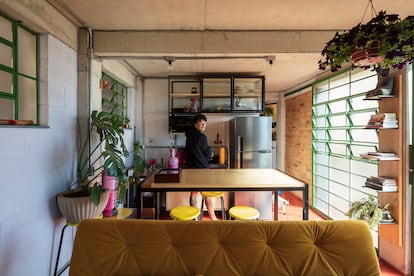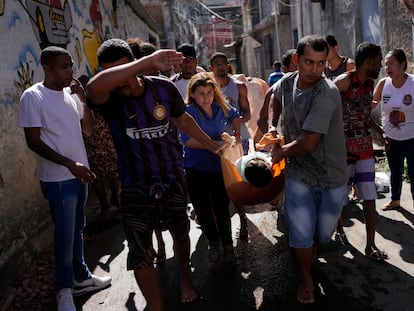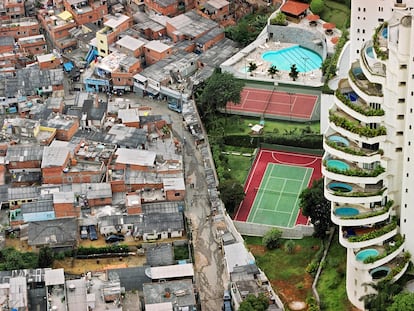Home in Brazilian favela is finalist in international architecture competition
The house of artist Kdu dos Anjos, built by the Levante Collective, is a modest brick construction in the middle of a shantytown in Belo Horizonte
From the favela to the world. The artist Kdu dos Anjos has been smiling from ear to ear since the prestigious architecture website ArchDaily nominated his home as Building of the Year 2023. His little dwelling, “the shack” as he calls it, is a 66-square-meter brick house located in a narrow alleyway in Aglomerado da Serra, a favela on the outskirts of Belo Horizonte.
Despite its simplicity – or precisely because of it – Kdu dos Anjos’s home has made it to the top five and is now competing head-to-head with elaborate mansions. The house is the work of the Levante Collective, while architects Fernando Maculan and Joana Magalhães came up with the design. The biggest draw card of the design is its ability to mix textbook architecture with the intuitive self-construction of the favela. This is topped off with the creative use of very simple materials.
“When an architect arrives in an area, a favela, the first thing they have to do is listen to and recognize the values of that place,” explains Maculan, who met Kdu dos Anjos while working on another neighborhood project. There was instant chemistry between the two, so much so that Kdu gave him hardly any instructions about what he wanted to build on his small piece of land. The only thing he was clear about what that he wanted to respect the surrounding architecture, using features such as exposed brick and cement floors, in order to give the home both an industrial and retro feel.

At first glance, the house is very similar to those in the rest of the neighborhood. The main difference is its reinforced structure and that the bricks have been placed horizontally – normally in the favelas, they are installed vertically to save material and time. At first, the neighbors did not understand what all the fuss was about, but now they consider it a “work of art,” says Kdu.
The home also has thicker walls to improve insulation, and floor-to-ceiling windows, which let in more natural light and better ventilation. These small improvements can be easily reproduced, says Maculan. For the architect, the competition is an “opportunity to rethink the favelas in Brazil, from a perspective of neighborhood pride, and of valuing the people.”
Kdu, who works at the Lá da Favelinha cultural center and shares his home with plants, two dogs and a cat, agrees that being included in the finalists is helping to challenge prejudices about favelas. “The news from here is usually about shootings, violence, drugs, drug trafficking, houses falling down. And here we are talking about the opposite, of a house rising up,” he says, smiling.
Sign up for our weekly newsletter to get more English-language news coverage from EL PAÍS USA Edition
More information
Archived In
Most viewed
- Sinaloa Cartel war is taking its toll on Los Chapitos
- Oona Chaplin: ‘I told James Cameron that I was living in a treehouse and starting a permaculture project with a friend’
- Reinhard Genzel, Nobel laureate in physics: ‘One-minute videos will never give you the truth’
- Why the price of coffee has skyrocketed: from Brazilian plantations to specialty coffee houses
- Silver prices are going crazy: This is what’s fueling the rally


